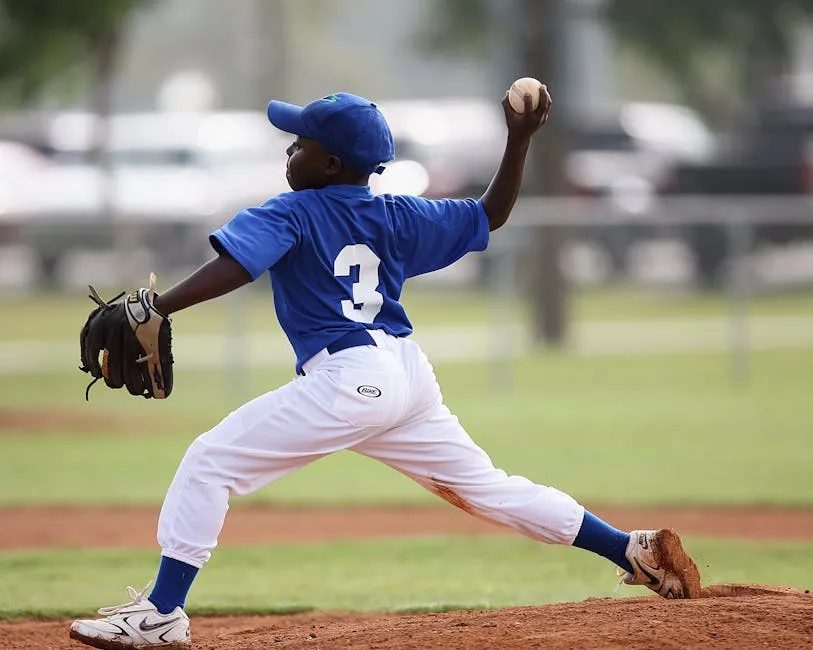Introduction
The National Junior College Athletic Association (NJCAA) plays a vital role in college baseball. It provides an opportunity for student-athletes to compete at a high level while pursuing their education. With over 500 member institutions, the NJCAA serves as a stepping stone for many players aiming to reach professional levels or transfer to four-year universities.
Statistics are the lifeblood of baseball. They help assess player and team performance, giving coaches, scouts, and fans a clearer picture of the game. Understanding these metrics is essential for identifying talent and potential. From batting averages to earned run averages (ERA), every number tells a story.
This article aims to break down NJCAA baseball statistics comprehensively. We’ll dive into hitting, pitching, and fielding metrics across different divisions. By the end, you’ll understand how these stats can influence player scouting and recruitment decisions.
So, grab your favorite snack and get ready to explore the fascinating world of NJCAA baseball stats. Whether you’re a player, coach, or just a curious fan, the insights gained here can make a significant difference in your appreciation of the game.
Speaking of snacks, if you want to fuel your baseball watching experience, consider stocking up on Healthy Snack Packs. They’re perfect for keeping your energy up while you crunch those numbers!

Understanding NJCAA Baseball Statistics
What is NJCAA Baseball?
The NJCAA governs community college athletics in the United States. It comprises three divisions, each with its own championship series. Division I, Division II, and Division III schools compete for glory, showcasing a wealth of talent.
Baseball holds a special place within the NJCAA community. It’s one of the most popular sports, attracting thousands of players annually. The competition is fierce, and the level of play is impressive. Many athletes use their time in the NJCAA to hone their skills before moving on to larger programs or professional teams.
The structure of the NJCAA ensures that student-athletes receive a well-rounded experience. They balance academics with athletics, preparing them for future success on and off the field. In short, NJCAA baseball is a crucial component of the college sports landscape, providing valuable opportunities for aspiring baseball players.
To excel in this environment, having the right Baseball Equipment Bag is essential. It keeps your gear organized and ready for action, so you can focus on what truly matters—playing your best!
Importance of Statistics in Baseball
Statistics in baseball are like a Swiss Army knife for coaches, players, and fans. They’re indispensable tools that help evaluate player performance, shape strategies, and track team success. Imagine trying to judge a player’s skill without numbers. It’s like trying to bake a cake without a recipe!
Statistics provide clear insights. For coaches, they inform game tactics. For players, they highlight areas for improvement. Fans? Well, they provide endless banter during the game. “Did you see his batting average?” is a phrase that keeps the excitement alive!
Common metrics include batting average, earned run average (ERA), and on-base percentage. Batting average gives an idea of a hitter’s success at the plate. ERA evaluates a pitcher’s effectiveness, showing how many earned runs they allow per nine innings. On-base percentage measures how frequently a player reaches base, combining hits, walks, and hit-by-pitches.
To track your own progress, why not use a Fitness Tracker? It can help you monitor your workouts and performance metrics, just like the stats you admire in your favorite players!

Other metrics like home runs, runs batted in (RBIs), and stolen bases add depth to player evaluation. They tell stories of power hitters, clutch performers, and speed demons on the basepaths. Each statistic contributes to a comprehensive understanding of players’ skills and their impact on the game.
In the cutthroat world of college baseball, these stats can make or break a player’s future. They are essential for scouts and coaches looking to build winning teams. So, whether you’re a player striving to improve or a fan enjoying the thrill of the game, understanding these stats is crucial. They encapsulate the drama, the excitement, and the artistry of baseball, all in a series of numbers.
NJCAA Division II Statistics
Hitting Leaders
The NJCAA Division II showcases impressive hitting talent. Here are the leaders in key hitting metrics for the latest season:
- Batting Average
- Brady Krzciok, Macomb: .512
- Julio Guerrero, North Central Missouri: .503
- Kyle Koehler, Cuyahoga: .497
- Aaron Piasecki, Kellogg: .481
- Alex Harrell, ASU Mountain Home: .469
- Runs Batted In (RBI)
- Harrison Bowman, Iowa Central: 94
- Landen Johnson, Northern Oklahoma Tonkawa: 90
- Camden Kaufman, Des Moines Area: 76
- Will Smoot, Iowa Central: 76
- Cameron Hill, Hinds: 74
- Home Runs
- Derek Cerda, Western Oklahoma State: 21
- Hollis Porter, Pearl River: 20
- Cooper Nicholson, Iowa Central: 20
- Chris Arroyo, Pasco-Hernando State: 19
- Landen Johnson, Northern Oklahoma Tonkawa: 19
- Stolen Bases
- Preston Leon, Lansing: 59
- Josh McClintock, East Central (MO): 56
- Dawson Willis, LSU Eunice: 54
- Carson McCoy, Patrick & Henry: 54
- Sam Ross, Anne Arundel: 48

Pitching Leaders
When it comes to pitching, Division II players also shine. Check out the top pitchers:
- Earned Run Average (ERA)
- Michael Carpenter, Madison: 1.03
- Cesar Morales, Frederick: 1.41
- Ian Koosman, Paradise Valley: 1.52
- Mathew Murtagh, Sullivan County: 1.74
- Alec Beversdorf, LSU Eunice: 1.84
- Wins
- Owen Schexnaydre, LSU Eunice: 15
- Blake Lobell, LSU Eunice: 15
- JT Schnoor, Pearl River: 12
- Griffin Smith, Rock Valley: 11
- Reigh Jordan, Wallace-Dothan: 11
- Strikeouts
- Blake Lobell, LSU Eunice: 129
- Luke Cooley, East Central (MS): 115
- Landon Waters, Meridian: 115
- Griffin Smith, Rock Valley: 113
- Michael Carpenter, Madison: 111

NJCAA Division III Statistics
Hitting Leaders
The competition in Division III is fierce, with players making their mark in hitting stats:
- Batting Average
- Rocko Brzezniak, Brookdale: .568
- Caden Dulin, RCSJ Gloucester: .496
- Jackson Rains, North Arkansas: .489
- Christopher Picarella, Nassau: .484
- Nick LoVarco, Brookdale: .473
- Runs Batted In (RBI)
- Caden Dulin, RCSJ Gloucester: 98
- Max D’Alessandro, RCSJ Gloucester: 87
- Rocko Brzezniak, Brookdale: 82
- Gavin Degnan, RCSJ Gloucester: 79
- Payton Poole, Dallas College – Eastfield: 79
- Home Runs
- Seth Tierney, Century: 20
- Max D’Alessandro, RCSJ Gloucester: 19
- Nick LoVarco, Brookdale: 19
- Augusto Mungarrieta, Rochester: 15
- JJ Bush, Dallas College – Eastfield: 13
- Stolen Bases
- Braden Cummings, Northampton: 48
- Tori Uhlich, North Dakota SCS: 45
- Owen Silliman, SUNY Niagara: 45
- Yan Ortiz Torres, Monroe College – Bronx: 45
- Brett Johnson, SUNY Niagara: 44

Pitching Leaders
On the mound, Division III players are delivering impressive performances:
- Earned Run Average (ERA)
- Andrew Johnson, SUNY Niagara: 1.22
- Jayden Voelker, Northern Essex: 1.48
- Ryan Cole, Brookdale: 1.94
- Jose Laguna, Bunker Hill: 1.94
- Sotaro Ishida, Herkimer: 1.96
- Wins
- Marcus Peters, Dallas College – Eastfield: 12
- Tyler Do, Dallas College – Eastfield: 11
- Bron Farr, Dallas College – Richland: 10
- Austin Beard, Northampton: 10
- Jake Burt, Brookdale: 10
- Strikeouts
- Jayden Voelker, Northern Essex: 126
- Jack Turner, Suffolk County: 119
- Michael Wansaw, Middlesex College: 108
- Adrian Quezada, Monroe College – Bronx: 105
- Marcus Peters, Dallas College – Eastfield: 104

Player Development and Scouting
Impact of Statistics
Statistics play a crucial role in player recruitment and development within the NJCAA. For coaches and scouts, numbers are more than just digits; they are indicators of potential. A stellar batting average or a low ERA can catch the eye of recruiters. These stats help create a player’s profile, showcasing strengths and weaknesses.
For a comprehensive overview of how statistics impact player performance, check out this article on LSU Baseball Statistics.
Coaches utilize these metrics to tailor training programs. For instance, if a player struggles with strikeouts, coaches can develop specific drills. This data-driven approach enhances training efficiency and player growth.
Moreover, statistics provide a competitive edge. With the right metrics, coaches can build stronger teams. They can identify talents who excel in specific areas, such as speed or power. This targeted recruitment leads to more balanced and successful rosters.

If you want to sharpen your skills, consider using Baseball Training Aids. These tools can enhance your performance and help coaches fine-tune their strategies.
Success Stories
Several notable players have made the leap from NJCAA to Major League Baseball, proving the system’s effectiveness. Take Caden Powell, for instance. During his time at Seminole State, he amassed an impressive 32 home runs and a batting average of .502. His standout performance caught the attention of MLB scouts, ultimately leading him to a professional career.
Another inspiring story is that of Derek Cerda from Western Oklahoma State. He demonstrated exceptional power with 21 home runs and a batting average of .321. His success in the NJCAA paved the way for him to be drafted into the MLB, showcasing how vital statistics are in shaping players’ futures.

These success stories illustrate the importance of statistics in the NJCAA. They not only help players to get noticed but also support their development into professional athletes. The numbers tell a story, and for many young talents, that story leads to the big leagues.
Conclusion
Summary of Key Points
In conclusion, NJCAA baseball statistics are indispensable for players, coaches, and scouts. By providing a clear assessment of performance, these metrics help identify talent and potential. Players can leverage their stats to improve their game and secure recruitment opportunities. Coaches benefit from data-driven decisions, leading to well-rounded teams.
Future of NJCAA Baseball
Looking ahead, data analytics will likely reshape the landscape of NJCAA baseball. As technology advances, the ability to analyze player performance in real-time will become more prevalent. Coaches will have access to deeper insights, allowing for more precise adjustments. This evolution could enhance player development further, creating a new generation of baseball stars.
Final Thoughts
For aspiring players, focusing on statistics is vital. By understanding and improving their performance metrics, they can enhance their chances of success. Whether it’s refining hitting techniques or bolstering pitching skills, numbers matter. So, keep an eye on those stats; they may just be the key to unlocking a bright baseball future.
And while you’re at it, don’t forget to grab a Baseball Glove that fits you just right—after all, you can’t catch those stats without a good glove!

FAQs
What is the NJCAA?
The National Junior College Athletic Association (NJCAA) is a key player in college athletics. Founded in 1938, it oversees community college sports in the United States. The NJCAA consists of over 500 member institutions spread across three divisions: Division I, Division II, and Division III. Each division has its own championship series. The NJCAA provides student-athletes with the chance to compete at a high level while pursuing their education. This association is crucial for nurturing young talent, as it serves as a pathway to professional sports or transfer to four-year universities.
How are NJCAA statistics compiled?
Tracking statistics in NJCAA baseball is a well-organized affair. Each game, teams record performance metrics, such as hits, runs, and errors. Coaches and statisticians compile these stats during and after the game. These numbers are then reported to the NJCAA. The association updates the official statistics regularly throughout the season. This ensures that players and fans have access to accurate and timely data. Moreover, NJCAA emphasizes transparency, making it easier for scouts and coaches to evaluate player performance.
Why are statistics important for players?
Statistics are the lifeblood of a player’s career. They offer insights into performance, helping players understand their strengths and weaknesses. For aspiring athletes, stats can be the ticket to recruitment opportunities. Coaches and scouts closely examine these numbers when assessing talent. A standout batting average or a low ERA can catch a recruiter’s eye. Furthermore, good statistics can lead to scholarship offers, allowing players to continue their education while playing the sport they love. In short, a player’s stats can significantly influence their future in baseball.
How can I access NJCAA baseball statistics?
Accessing comprehensive NJCAA baseball statistics is easier than ever. The official NJCAA website is the best place to find up-to-date stats. You can visit [NJCAA Baseball Stats](https://njcaa.org/sports/bsb/index) for a detailed breakdown of player and team performances across all divisions. This resource includes leaderboards, game results, and seasonal averages. Additionally, regional websites often provide specific stats for local teams. Whether you’re a coach, player, or fan, these resources are invaluable for following the action in NJCAA baseball.
Please let us know what you think about our content by leaving a comment down below!
Thank you for reading till here 🙂
All images from Pexels




